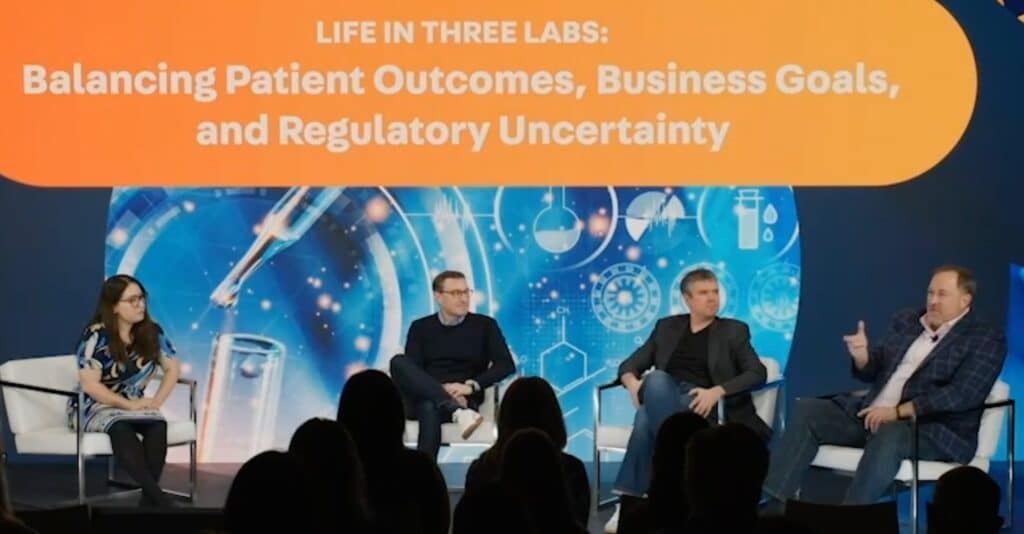Healthcare marketers today are navigating rapid change. Reshaping the industry as we know it, new privacy laws and technologies like generative AI create an air of uncertainty around health advertising’s next era. Last week, DeepIntent’s AdLab Health Marketing Summit brought healthcare, pharma, and ad tech leaders together to explore vital opportunities to adapt creatively and collaboratively.
In between the event’s expert panels, we made time for one-on-one interviews with attendees to learn more about the challenges and opportunities shaping their strategies this year.
What can their thoughts tell us about the current state of health advertising? “Every pharma marketer and organization is in a state of change,” said Melissa Gordon-Ring, Global President of Health at Initiative. “Everyone is trying to learn and move faster than ever.”
Our other guests proved Gordon-Ring right, sharing how they’re working to ensure strong campaign performance and patient outcomes no matter what the future holds.
Privacy, Privacy, Privacy
When asked about the biggest challenge they face this year, 11 out of 15 interviewees discussed the privacy landscape. “Privacy, privacy, privacy. Who’s not talking about it?” commented Bill Veltre, EVP and Head of Media at Deerfield Agency. “With the legislation that’s coming through, we’re all being challenged to develop better standards to deliver transparent data and information to our clients.”
“All these new state regulations are a big challenge for the industry, for sure,” Elissa Liu, CEO of Spark Growth, added. “It’s about ultimately connecting with our audiences, engaging them, but at the same time, needing to do that within the confines of regulatory.”
While consumers have come to expect more personalization in advertising, an influx of different state privacy laws in the last few years has made it harder to achieve. State by state, healthcare marketers need to be aware of the laws already in place, the laws on the horizon, and how their audience targeting will be impacted.
In response to this, Barry Miller, Director of Channel Partnerships at IQVIA, said, “I’d like to see the federal government step in so that at least there’s one uniform standard, because going down this rabbit hole of 50 different standards and deprecating different states is getting scary. Eventually, we’re going to reach critical mass.”
Opportunities with AI, Integrated Campaigns, and First-Party Data
While discussing the change marketers are facing, we also wanted to learn about the change they’re pioneering. Artificial intelligence (AI) was mentioned by many guests, like Veltre, who wants to “effectively use AI to help us extend and/or streamline our processes as an agency, and ultimately provide more value to our clients.”
Following the panel discussion about experimenting with integrated campaigns, Matt McNally, panelist and CEO of Omnicom Health Group, highlighted the importance of continuing to “break down the silos between physician and patient advertising” to drive better patient outcomes. From his perspective, there are “ways that we can use data, ways that we can use creativity, ways that we can use content, and ways we can look at how we’re operationalizing business to break down those silos [to] give us a better outcome for patients and providers.”
On the subject of integration, Mike Caruso, VP and Director of Biddable Media at SSCG, is excited to continue testing “integrated measurements and activations” and exploring whether they can achieve better measurement with direct buys versus programmatic buys. “Over the last six months, we’ve been analyzing different channels—audio, EHR, or digital out-of-home—and have started to take those formats and analyze them to figure out for each client what is the best path forward.”
What about one of the other transformations on people’s minds—going cookieless? Rich Pisciotta, Director of Programmatic at SSCG, described the challenge of “coaching clients through the chaos that is identity resolution,” but believes that their first-party data will “become the backbone of what we do. I think that this push towards authenticated data or an ID is going to help bridge some of the gaps of a cookie that was never perfect to begin with.”
As the health advertising landscape evolves, Ellie Kwon, VP of Addressable Media at Kinesso, is grateful for opportunities to collaborate with industry peers. “I feel like we’re in this together as an industry, and we’re trying to solve this together. We don’t have to figure this all out for ourselves.” Alan Sy, Senior Manager of Brand Safety and Media Operations at Johnson & Johnson, agreed. “It’s nice to hear that everyone—ad tech, brand, client, agency—we’re all working together on all the challenges.”
Want more insights from AdLab Health Marketing Summit? Read our blog for the top three takeaways.


